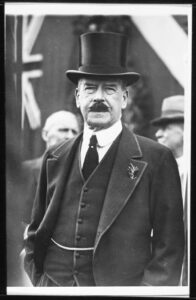1929: The Mau Riot
December 28, 2022
By AHNZ
 Today in history, 28 December, 1929 was Black Sunday in Western Samoa. Like Germany before WW1, New Zealand was then and is now the regional hegemon over Samoa and Samoans and this has been rightly resented by the locals all along. To enslave a population by chaining their bodies is expensive and unworkable so it’s essential to find some workable story so that they will enforce their own captivity. It’s true that “stone walls do not a prison make, Nor iron bars a cage.” The prison and the cage storytelling matrix that New Zealand had woven for Samoa was wearing thin and openly defied between 1926 and 1936 by a rebel organisation called Mau. Black Sunday was the high point of Mau resistance and a time where the New Zealand State slipped into the violent vertical enforcement of power that always backs the preferred horizontally enforced (peer-to-peer/slave-on-slave) internalised violence over everyday life.
Today in history, 28 December, 1929 was Black Sunday in Western Samoa. Like Germany before WW1, New Zealand was then and is now the regional hegemon over Samoa and Samoans and this has been rightly resented by the locals all along. To enslave a population by chaining their bodies is expensive and unworkable so it’s essential to find some workable story so that they will enforce their own captivity. It’s true that “stone walls do not a prison make, Nor iron bars a cage.” The prison and the cage storytelling matrix that New Zealand had woven for Samoa was wearing thin and openly defied between 1926 and 1936 by a rebel organisation called Mau. Black Sunday was the high point of Mau resistance and a time where the New Zealand State slipped into the violent vertical enforcement of power that always backs the preferred horizontally enforced (peer-to-peer/slave-on-slave) internalised violence over everyday life.
The story New Zealand told Samoans about why they were the rulers has had to change and be perfected over time. In 1929 it was very far from perfect whereas these days Samoa is just as much under control but under the perfect illusion that they are their own independent nation. “…Western Samoans kept on pushing for freedom and home rule. Labour 1.0 rejiggered the matrix so it would feel as if they had it and that strung them along until 1962. In this year National 2.0 rejiggered the matrix again under the branding of the Treaty of Friendship.” Ref. 1962: The Treaty of Friendship, AHNZ
The failing story matrix attempted by Administrator of Western Samoa George Richardson was Samoa for the Samoans. This he translated as Samoa mo Samoa and what he really meant was ‘Western Samoa for New Zealand.’ The native leaders reacted with the Samoa Mau movement which took up the State’s slogan and used it against the imperialist New Zealand occupiers. There was a glitch in the Statrix!
The Mau problem was allowed to be born, develop, and then die the natural death of all history cycles. While it lasted the Mau had an organised program of civil disobedience. They refused to recognise State representatives, pay taxes, clean their villages, or participate in the eradication of the rhinoceros beetle. They paid tax to their own shadow government, had hundreds of their own Mau policemen, own administration building, and their own newspaper. The Mau Police picketed certain stores in Apia and enforced a ‘tax’ of their own on shoppers!
Mau founder and exile, wealthy and powerful Samoan, Olaf Nelson, lobbied for the Mau in New Zealand and the League of Nations in Geneva.
Administrator Richardson made so many arrests the jails were full and he had to let them go. Eventually though the spark died and the rival administrations came to terms. A new story was found. The Samoans put the Mau Generation behind them. And, I’m sure, more carbohydrates were made cheaply available which always makes a population obedient and docile.
“The truth is, the Matrix was a documentary” – Keanu Reeves
“In Western Samoa, for example, New Zealand’s autocratic administrator General Sir George Spafford Richardson enforced a policy that he called “Samoa mo Samoa,”…Samoa finally gained self-government in 1959 and independence in 1962. But as Malcolm McKinnon observed, “Independence meant to New Zealand something different from its meaning in Africa and Asia…Future governors of the country were expected to be both well disposed towards New Zealand and also in full control of their country.”..regional hegemony persisted…It is more subtle today, but very much alive.” – p337, Fischer (2012)
“Its slogan, which ironically enough, had been formulated by the Government as the aim of its reforms, was Samoa mo Samoa….The lesson learned by the British Government in New Zealand, was now, sadly and slowly, learned by the New Zealand authorities in Samoa: benevolence is not enough.” – p249 Sinclair (1959)
“The Mau then began a multifaceted resistance campaign. District councils, village committees, and women’s welfare committees established by the administration halted their regular meetings and formed their own Mau ‘police force’. Villages ignored visiting officials and withdrew children from government schools. Workers engaged in acts of noncooperation in coconut and banana plantations. Instead of paying taxes, Samoans contributed money to the Mau.” – Ken, SAMOA MO SAMOA, Facebook (2015)
“Between 1926 and 1936 a programme of civil disobedience was organised and became known as the “Mau”. (Part of its origins may be traced to Samoan discontent over the loss of certain high titles.) It took the form of an “unofficial opposition” to the Administration and was allowed to wax and wane. Rather than being a Samoan Nationalist movement, the Mau has been regarded as a reflection of factionalism, or a traditional Samoan lack of national unity.” – Encyclopedia of New Zealand (1966)
 Black Sunday was a direct result of an attempted kidnapping (or “arrest,” depending on whose narrative) of one of the Mau who was one of their ‘wanted men’. It was during a large parade welcoming back the Australian Alfred Smyth, a Mau compatriot, that this arrest was attempted. In resisting, the Mau clubbed one of the Government policemen to death and then rioted on the remaining officers who retreated to their police station under siege. Warning shots were fired by the police from their balcony over the mob with a machine gun. Some more warning shots were fired from policemen rifles at ground level into the riot with the result of 12 dead and 50 wounded. The Mau retreated, were hunted for months, and it was some time before any kind of peace was found and the Statrix remade.
Black Sunday was a direct result of an attempted kidnapping (or “arrest,” depending on whose narrative) of one of the Mau who was one of their ‘wanted men’. It was during a large parade welcoming back the Australian Alfred Smyth, a Mau compatriot, that this arrest was attempted. In resisting, the Mau clubbed one of the Government policemen to death and then rioted on the remaining officers who retreated to their police station under siege. Warning shots were fired by the police from their balcony over the mob with a machine gun. Some more warning shots were fired from policemen rifles at ground level into the riot with the result of 12 dead and 50 wounded. The Mau retreated, were hunted for months, and it was some time before any kind of peace was found and the Statrix remade.
According to Michael King Governor-General Fergusson was initially unable to find Prime Minister Joseph Ward or any of his Ministers or their lackies to meet the crisis. Apart from, probably, being on extended Christmas holidays as our politicians do, the Ward Ministry really was a zombie organisation. Old man Ward was only nominally in charge, sick and getting sicker, leaving power in the hands of his lieutenants and his private secretary and (unelected) son, Vincent. The Ministry had had lost all momentum and old Ward had been seen falling about the passages. He hadn’t long to live. Ref. 1930: Death of Joseph Ward, AHNZ
So, the blame for the disgraceful killings on Black Sunday went all the way to the top. This is not to excuse rebels like Olaf Nelson or Alfred Smyth who were playing their own power games. The story of Black Sunday and the Mau uprising should be remembered as a lesson in what The State is and how it controls Samoans. And, of course, The State uses exactly the same storytelling and horizontally enforced peer pressure to keep the population of New Zealand under control too. No rebel group could reasonably expect to have more conviction and organisation than the Mau Rebellion achieved at its best yet they failed.
Anyone trying to successfully execute a revolution in the Matrix of their own country ought to take note of that and give up on it. Do it another way. It’s not ‘a’ Matrix that needs to change it’s the doing away with the Matrix entirely. Exiting Plato’s Cave. Undoing the propaganda. That’s what Anarchist History of New Zealand is for.
—
Image ref. Samoans rampaging. Hobbs and Shaw (2019)
Image ref. deja vu cat from The Matrix (1999,) Screen Rant
Ref. Fairness and Freedom, David Fischer (2012)
Ref. p323 The Penguin History of New Zealand, Michael King (2003)
 Like Comment Share
Like Comment Share





